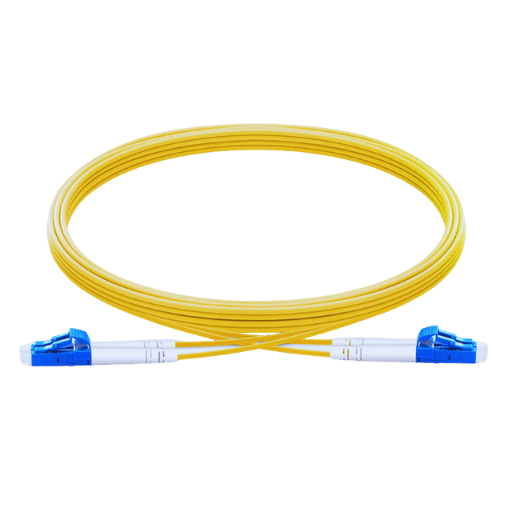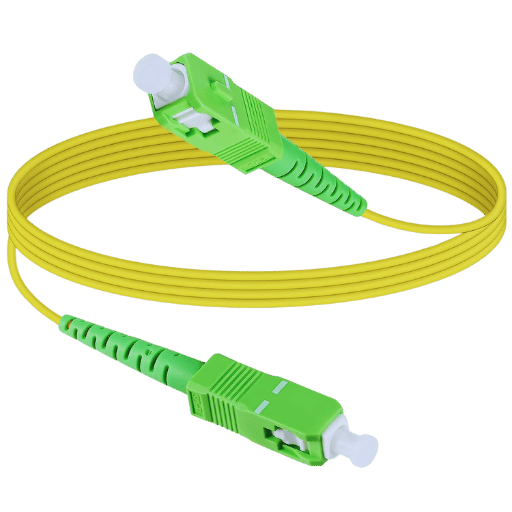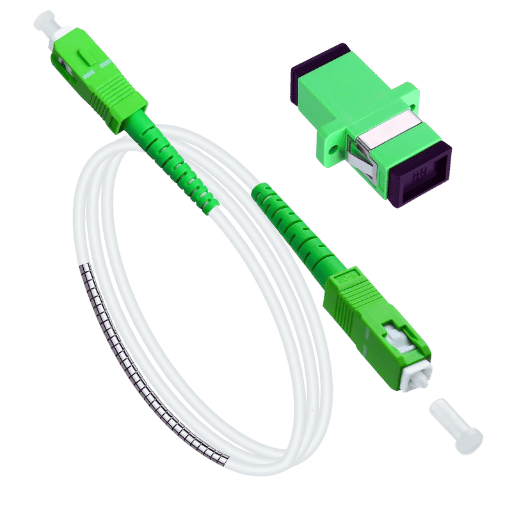The single-mode optical fiber cable is crucial to contemporary telecommunication systems since it facilitates efficient data transfer over long distances and offers minimal signal deterioration. Whether you are an IT specialist, a network manager, or just a curious individual interested in the technology that interconnects the world, knowing single-mode fiber is fundamental. This guide will delve into its essential features, benefits, and actual uses. This article explains single-mode fiber’s importance in today’s communications infrastructure, including its exceptional bandwidth capabilities and significance in high-capacity networks. Continue following us as we expose the science, advantages, and practical aspects of implementing the technology.

A single-mode fiber optic cable is an optical fiber designed to propagate light signals over long distances with minimal attenuation. It comprises one glass or plastic fiber and features a tiny core of about 8-10 microns in diameter. This small core permits only one light mode to propagate through the cable, minimizing signal degradation and increasing transmission efficiency. Single-mode fiber is used primarily in high-speed communication networks, such as telecommunications and data centers that require long-distance connections with high bandwidth. It transmits laser light perfectly aligned to the fiber core to ensure accurate and dependable data transfer.
Single-mode fiber guides light through a solitary, thin channel, reducing signal attenuation and interference. This design is critical for telecommunications, internet backbones, and advanced data center networks because it enables high-speed data transmission over long distances. Its use of laser light ensures signals are accurately aligned, thus enhancing the system’s operational reliability and efficiency, which is essential for modern communication systems.
The main differences between single-mode and multimode fiber are in their core size, performance, and applicability. Single-mode fiber has a smaller core and can transmit light over longer distances with less distortion, making it ideal for long-haul communications and high-speed networks. Multimode fiber has a larger core that supports multiple light paths and is more suitable for short-distance connections like data centers and campus networks. Although multimode is cheaper for low-distance applications, single-mode provides more bandwidth and scalability for highly demanding networks.
The core diameter of the single-mode cables is critical because it influences the transmission of light signals. In single-mode fibers, the core diameter is small, usually in the range of 8 to 10 microns, which allows the propagation of only one light mode. This helps to reduce signal attenuation and interference. Therefore, single-mode cables are suitable for long-distance and high-bandwidth applications. The small core size ensures control of the light signals, causing reduced dispersion, which enhances the data sent over long distances in large networks.

Single-mode fiber optic cables offer an unparalleled advantage over multi-mode wires in bandwidth and distance. They enable data transmission over long distances with relatively low signal degradation, making them useful for many long-distance telecommunication or data transmission services. Moreover, due to their greater bandwidth, single-mode fibers maintain an ongoing trustful data transfer across vast networks. These characteristics make single-mode fibers preferred for high-performance and large-scale communication systems.
Attenuation describes the gradual decline in the strength of a signal as it travels through a medium, such as an optical fiber. This signal devaluation can negatively affect data transmission reliability, accuracy, and speed in communication systems. Attenuation is commonly attributed to fiber absorption, scattering, and bending losses. To alleviate these impacts, signal repeaters and amplifiers are used alongside high-quality materials and optimized fiber design to sustain signal reliability and performance over long distances.
Single-mode fiber is a common choice for high-speed networks because it can transmit data over long distances with negligible loss and interference. Because it has a smaller core diameter, which allows single-light mode transmission, dispersion is reduced, and consequently, communication becomes faster and more reliable. Because of these features, single-mode fibers are perfect for backbone internet connections, data centers, and telecommunication systems where bandwidth and transmission distances are very high.

Constantly tailor aspects such as the purpose and scope of the single-mode fiber optic cable while choosing the appropriate connector. Some prevalent types are LC, SC, and ST, which have different applications. LC connectors are space-saving and best suited for high-traffic areas like data centers. SC connectors are widely used in telecommunications because of their simple push-pull feature, allowing for effortless installation. ST connectors are standard in industrial settings because of their twist-and-lock design. Always check with your equipment and select the connectors that will provide the best performance relevant to the cable and its application.
OS2 single-mode fibers are intended for long-range, high-performance activities or tasks. They work at 1310 and 1550 nm wavelengths, where OS2 fibers have minimal signal loss and maximum efficacy. OS2 fibers have proper range control, ensuring a maximum distance of 10 kilometers at 1310 nm and over 40 kilometers at 1550 nm. This performance makes the fiber suitable for outdoor use. It is used in telecommunications, metropolitan fiber networks, and backbone fiber infrastructures where high reliability and extended operational range are crucial.
While assessing cable products for a given application, there are three essential factors to evaluate distance, bandwidth requirements, and environmental factors, such as in riser and plenum areas. The OS2 single-mode fibers are recommended for long-distance and high-speed transmission because of their low attenuation and long-range capability. Where distance is short, or flexibility is essential, OM3 or OM4 multimode fibers are more appropriate because of their high data rates over moderate distances. Also, remember that the selected cable meets the rating requirement for the installation environment, whether indoor, outdoor, or underground. Also, as with any product, industry standards check compatibility and performance, such as ANSI/TIA-568.

During the installation of outdoor armored fiber optic cables, make sure to clear the pathway of sharp contours or any shapes that could hinder the cable’s casing. Use appropriate conduits or ducts for additional protection in areas with physical threats. Confirm the cable is compliant with any applicable external-rated requirements, such as, but not limited to, UV and moisture resistance. For underground deployment, confirm adequate burial depth and place warning tape above the cable to facilitate identification during future excavation works. Bond the cable’s metallic armor to the ground where needed to reduce potential electrical risks and interference. There should also be optimal tension applied to the cable so that there is no strain or deformation during installation. Follow all instructions issued by the molding, such as ANSI/TIA-758, for control and safety specifics.
Proper connection of fiber patch cords is necessary to yield high network performance and improve efficiency by minimizing signal loss. Always remember to check that the type of connector, whether LC, SC, or ST, is compatible with the gauge of equipment employed and the cable. If any of these aspects are misaligned or misconnected, it would increase insertion loss and decrease signal quality overall.
It is important that all connectors are cleaned and free of extraneous dust and debris, as this can result in much more signal loss than necessary. Studies in the industry highlight that dirt is responsible for over eighty-five percent of fiber optics failures, which highlights the critical need for maintenance. Ensure that surfaces are free, using specialized cleaning tools like labeled wipes with isopropyl alcohol and automated cleaning devices to obtain pristine surfaces.
A fiber inspection microscope is used mandatorily to check the alignment and the cleanliness of the individual patches inside the connector. Ensure also that the polarity is set for the case of the patch cord used. Cross-check and confirm the requirement matches with a gauge of fiber OS1, OS2, OM1, OM2, OM3, and OM4 set for single and multi-mode fiber to avoid problems with disparities in performance. Each connection should be checked for compliance with performance standards using an Optical Power Meter, Optical Time Domain Reflectometer, or OTDR.
Systemically organized patch cords at the patch panel using cable management techniques such as guides and labels have been accomplished. This strategy helps reduce the chances of physical damage to the network and makes maintenance much more manageable. Moreover, documenting the patch cords’ type, location, and other details enhances network performance while minimizing the time required for maintenance, particularly in custom cabling configurations.
External environmental factors heavily impact the longevity and effectiveness of cables. Elements like extreme heat or cold, humidity, physical strain, UV radiation, and stress will all affect the insulation of a cable, reducing its efficiency. Outdoor cables face the threat of extreme UV exposure, which can break down materials, while high temperatures can result in fatigue due to thermal expansion. The corrosion risk, mold growth, signal quality, and structural integrity are all harmed by a humid environment. When designing cables for rugged environments, shielding alongside UV-resistant coatings and the correct insulation materials will help reduce these impacts.

The two wavelengths, 1310 nm and 1550 nm, differ primarily in their attenuation and applications in optical communication, which affects the type of fiber jumper used. 1310 nm fiber optic cables experience lower dispersion, offset by slightly higher attenuation than 1550 nm. On the other hand, the 1550 nm wavelength is perfect for long-distance transmission because it has minimal signal loss due to its position in the fiber’s low-loss window. However, the 1550 nm wavelength may need dispersion compensation at high data rates for long distances. These differences indicate that 1310 nm is better suited for shorter, high-precision networking applications, while long-range telecommunications are better served by 1550 nm.
Due to their long-distance and high-bandwidth supporting capabilities, single-mode fiber cables are employed in telecommunication networks, cable television systems, and data centers requiring connections over several miles. These scenarios are ideal thanks to single-mode fibers’ ability to maintain signal integrity and support higher transmission speeds.
On the other hand, multimode fiber cables are ideal for short-distance applications. They are often used for Local Area Networks (LANs) and data center connections in single buildings or campus settings. Mid-range transmission distances with moderate bandwidth requirements make multicore fiber cables the more cost-efficient option, thanks to their simpler installation and low cost.
Short- and long-term factors must be considered when examining the cost-effectiveness of fiber optic systems. In terms of initial cost, multimode fiber is more appealing than its single-mode counterpart due to its lower costs and easier installation. This makes multimode fiber more accessible for businesses with budget constraints or those who need to set up networks immediately. On the other hand, single-mode fiber is more expensive initially but more cost-effective in the long run. This is due to its higher data transmission speed and longer distances, which reduce the need for additional system upgrades and expansions in the future. The ultimate decision lies in the network specifications, anticipated growth, and available funding.
A: A single-mode fiber optic cable is a type of optical fiber through which light is transmitted in a single mode or path down the fiber core. The core size is small (9µm), which is best for longer distances and higher data transmission rates.
A: Unlike multimode fiber, which has a larger core and is optimized for shorter distances, single-mode fiber has a smaller core, which increases data transmission over long distances with little loss. Single mode usually allows a wider range of wavelengths for long-distance connectivity, while multimode is designed for higher bandwidth over shorter distances.
A: The OS1 and OS2 standards pertain to single-mode fiber cables. OS1 is meant for indoor use and has tighter bends with shorter max distances. At the same time, OS2 is designed for outdoor use and longer distance over-application with better performance due to lower attenuation rates.
A: Duplex fiber optic cables are the type with two strands of fiber. They are used when data needs to be transmitted in both directions at the same time. They are frequently used in two-way communication systems, such as transceivers and networking systems.
A: Single-mode fiber is preferred for long distances because it only has one path to propagate light, which minimizes the chance of interference and signal degradation in singlemode applications. Unlike multimode fiber, this increases the distance over which data can be transmitted without signal amplification.
A: A single-mode duplex fiber patch cable is a type of fiber patch cable that has two fiber strands and enables bi-directional communication. It is commonly used in high-speed networks that require signal transmission over long distances to have a minimal loss and is thus used with single-mode fiber patch cables.
A: Fiber connectors, or optical connectors, attach the strands of fiber in the fiber optic cable to other fibers or devices. They minimize losses, reflections, and misalignments and ensure precise alignment of the optical interfaces, which is vital for using single-mode fibers.
A: OS2 single-mode fiber supports long-haul and external uses that require low signal attenuation. Its greater performance supports its use in telecommunications, data centers, and any other location that needs dependability and durability from the provided fiber optic links.
A: The refractive index determines the pathways of light within the optical fiber. Single-mode fibers must have a specific refractive index difference between a core and cladding. This ensures the guiding light through the fiber achieves the precision necessary for minimal loss, thus maintaining the signal quality for extended distances.
1. Evaluation of attenuation levels for a single-mode fiber optic cable in some fiber plants located in Northern Nigeria
2. Creating the Attention Mechanisms of Single Mode Aerial Fiber Optic Cable Transmission about Connection Loss on Passive Splitter
3. Analyze Bending Loss on Single-Mode Fiber Optics